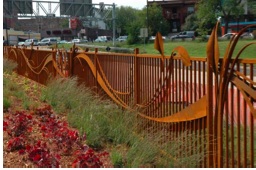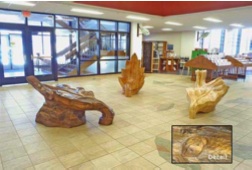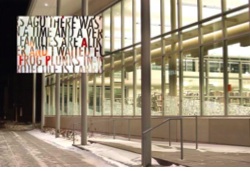Making Public Art Happen: Report on the Discussion
Amanda Vail went to the Minneapolis Art Commission's panel discussion at the Walker last Wednesday; she gives you the inside scoop on how to do public art for the city. Are you an artist or a citizen with an idea? Here's how to make it happen.



The Walker Art Center’s lecture room got crowded over the course of the evening as the panelists for the Minneapolis Arts Commission’s “Making Public Art Happen” discussion each presented their own angle on public art. Almost fifty people attended the event; most, by a show of hands, were artists, although a good handful were from community organizations interested in obtaining their own public art. It was interesting and informative; it became obvious that working within the process outlined by the City is pretty straightforward. And, even if the prospective artist or community group should get confused by the organizational levels, there are plenty of helpful resources available.
There were six panelists to offer their advice: Mary Altman, Public Arts Administrator of the City of Minneapolis; Lisa Elias, a metalworker who recently completed a piece for the City; Michelle Martin of the Peace Foundation, which has worked to create its own positive arts initiative in the Northside of Minneapolis; Ben Heywood, Director of the Soap Factory and former Arts Advisory Board member; Jack Becker, Director of the non-profit Forecast Public Artworks; and Mark Hinds of the Lyndale Neighborhood Association, standing in for Sara Linnes Robinson.
Without going into a blow-by-blow of the discussion and follow-up questions, several points came to light repeatedly. One is that the City really does want to promote art; the rules and procedures are there mainly to satisfy the very public nature of art in public spaces. Perhaps this should be obvious, but there are myriad factors to consider when creating artwork for the places where people live and work. In an attempt to grasp these, the City has spent a number of years drafting the Minneapolis Plan for Arts and Culture. In addition, there are the recently approved Public Art Policies and Procedures. Although massive and requiring quite a bit of sifting, these plans do contain most everything an artist or organization needs to know if they’re interested in creating or installing public art in the City of Minneapolis. Check out the Public Art Goals for information on what the City holds dear when approving or disapproving public art, or at least the ideas of public art, because there are technical issues to consider as well. However, Altman was very quick to note that, in the last five years, only one project that artists and community organizations have proposed to the city has been disapproved by the Minneapolis Arts Commission, and there have been none in the last two years.
But what is the process, exactly, for review? Basically, a piece of public art must first go up before the Public Art Advisory Panel, which looks at it as a work of art in the public sphere. Then the work is presented to the Minneapolis Arts Commission, which does its best to examine the work in terms of what the city will want from the piece. That is, technical issues: they need to think about public safety, accessibility, maintenance costs and structural concerns, copyright and signage, site control (who owns the property, exactly, and will the work cause any problems with neighbors?), and the overall capacity of the artist or organization (can they make this fly and actually complete the work?).
The Arts Commission will often make suggestions regarding the piece before approval because the next step is negotiating with Public Works and/or the property owner, which can be tougher. The good news is that, because the Arts Commission does its job so well, Public Works will often take their word for it, so to speak. The last stage is only for those making a gift of public artwork to the City, and that is approval by the City Council, which has to consider whether or not the city has the capacity to oversee and maintain the piece for the duration of its life. To help with this, all gifts of artwork to the city (which may be done in the case that the artwork might outlive the creating organization) have to come with maintenance endowments.
One of the Public Art Goals outlined by the city is to “Enhance Community Identity and Place.” This is certainly something that any neighborhood organization would be interested in. Jack Becker pointed out that, for the aspiring public artist, it’s important to remember that a piece of public art is a negotiated process between, as he says, “an artist’s vision and a community’s values.” The artist needs to engage in a dialogue with the community from the beginning so as to avoid problems, such as irate community members, later on.
“The community,” Becker says, “is not just a venue for display – get out and talk to people; it can be a humbling experience, but a valuable one.” This is not to say that an artist should create work that is ‘dumbed down’ or overly simple because the audience may not go to the Walker Art Center on a regular basis. Good quality artwork challenges the viewer, rewarding repeated, detailed viewing with new thoughts or surprises. However, good public art will still take into account the ideas and values of the community into which it is built.
Good examples of these projects were presented by Martin and Hinds. The Northside Pledge Stencil Project, assisted by the Peace Foundation,” arose from conversations about how to offset some of the negative things going on in North Minneapolis. A Northside pledge relating to building community and preventing violence was written by a collective of youth and adults; verses of this pledge were then stenciled on sidewalks throughout the area. Because the project involved the use of City property, Martin and the Peace Foundation did have to work through the city process, utilizing Altman and the Arts Commission. It all went smoothly, however, and took about two months from start to finish because, said Martin, “it was all about managing the steps in the process.” The Peace Foundation, as a non-profit, was able to help the community members immensely with funding as they were able to support the project out of their own operating funds. They plan to continue the project next summer on a larger scale, so will have to spend the winter fundraising.
Hinds spoke on the Wall Dogs project, a joint venture between the Lyndale Neighborhood Association and the Kingfield Neighborhood Association that involves painting six to ten murals along Nicollet Avenue from Lake Street to 46th Street in July 2008. Their motto is “Painting Murals, Building Community;” the idea is to make a safer neighborhood by getting people to invest, personally, in their property and community spaces. The murals, which will all be put up simultaneously during less than a week, will be directed by national and local “Walldogs” (traveling sign painters) but also feature the work of neighborhood members. The concerns addressed by the city for this project include sign issues (is it a sign or is it art? “Art” was, of course, the conclusion) and making certain that both the property owners and the business owners of the buildings are in approval.
The temporal nature of public art was also addressed. When thinking of building a project, artists and community groups should consider just what the duration of the work might be. It doesn’t have to be ‘forever;’ maybe a week, a month, two years is enough. Inevitably, the condition of the work will deteriorate and it will, perhaps, have to be removed, especially if it becomes a public hazard. Some, however, may sink gracefully into old age; Hinds is hoping the Nicollet Avenue murals will do just this. He doesn’t think that faded paintings will be an eyesore, just another memory to tie the neighborhood together; maybe they’ll even be the focus of another (restorative, this time) community effort twenty years from now.
One question rose after the main discussion: what resources are available to the emerging, or aspiring, public artist? For a large project, funding can be an issue for the artist, but partnering with neighborhood organizations or community groups make fundraising easier. Forecast Public Artworks also offers a number of grants as well as workshops and professional advice for those just starting out (grant deadline is November 15, but you’ll need to attend an information session before you apply. See the website).
As far as the application process goes, artist Lisa Elias advises artists to have good images of their work and a good summary of their proposal if they’re responding to an RFP (that’s “Request for Proposal”). She also reminds artists to follow all of the guidelines to the letter; omitting anything could mean that your proposal doesn’t even get reviewed. In addition, artists may have to learn new skills to meet the approval process for the city. Elias, for one, had to gain certification as a welder from the Minnesota Department of Transportation in order to begin work on “Stream of Trailing Reeds” because it serves as a fence between a bike path and a roadway.
The entire process of public art, as involved as it is, is also part of the meaning. It’s all about community and living spaces. For his upcoming project “From Here to Beyond,” artist Marcus Young is drawing and maintaining a blue line on Minneapolis sidewalks for a number of miles. To do this, he has had to go through Public Works and also notify property owners adjacent to the artwork. For something this long, that’s a lot of property owners. But it is also, according to Altman, part and parcel of his piece – it’s a process.
Ben Heywood asks that artists “interrogate public space, help us understand how we live and move through these spaces every day.” He sees a continuum between art, architecture, and public design that can, when put together, enhance not just the feeling of a neighborhood, but the sense of what it means to live in Minneapolis as a whole. So, jump in and contribute; there are many places to get involved, both for the artist and the community member. Public art in Minneapolis can happen.
As a side note, those wanting to celebrate the Brackett Rocket, a piece of iconic, local public art that has been recently reinvigorated, can do so with Forecast at the dedication event on Saturday, October 6th, from 3 to 5 pm at Brackett Park in Minneapolis.
There will also be an Iron Pour and Community Workshop at Jackson Square Park on Saturday, September 29th, from 1 to 5 pm. Interested parties can contact Mary Altman at 612-673-3006 or mary.altman@ci.minneapolis.mn.us.